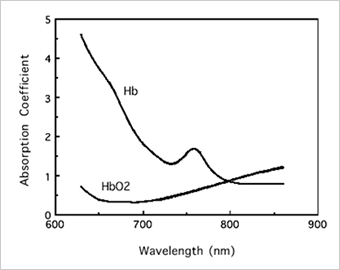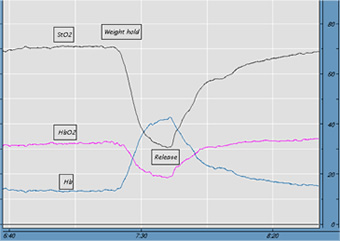The theory of the BOM series is based on the (modified) Beer-Lambert law. Some researchers report that the absolute value cannot be obtained from the Beer-lambert law, but can be from the Spatially Resolved Spectroscopy, SRS.
The both methods measure the attenuated light intensity received by a detector a few cm apart from the incident point. The light is attenuated by the scattering absorption by tissue itself and the absorption by blood (hemoglobin). The both methods only measure the same information, light intensity. However, one can shows the absolute value, and the other cannot. What is the differnce ? The reason is the number of hypothesis.
When the unknown factors are three, three equations are needed. The three equations by three lasers are obtained when the Beer-Lambert law is applied as,
I = ηIo exp [( -αVo – βVd)L’ – μs・L] (1)
The unknown factors are 1) oxygenated hemoglobin volume, Vo, 2) deoxygenated hemoglobin volume, Vd, and
3) attenuation coefficient of tissue, µ. When the three wavelengths are near each other, it is assumed that the attenuation coefficient, µ, is the same value for the all wavelengths. It is reported that the values of Vo・L’ and Vd・L’ are obtained from the three equations, however, the optical pass length, L’, cannot be measured and the absolute values of Vo and Vd cannot be obtained by using the Beer-Lambert law.
The other method, SRS, measures the light intensity at two points, r1 and r2, and Vo and Vd are calculated from the relation between the distance and detected light intensity. It is shown in Fig. 9.
μa x μs ≈ (ΔA/Δr – 2/r) (2)
Here, μa is the absorption coefficient related to the blood volume in tissue, A is the attenuation of light、and Δr = r2 – r1
1) The light intensity of different wavelengths are detected, and Vo and Vd are calculated from the equations. However, the absolute value of µa cannot be found if the absolute value of µs is unknown. This is the same condition as L’ is an unknown factor in the Beer-Lambert law. However, µs is assumed, for example, as 1.
The actual pass length of light is much longer than the distance between the incident – receiving points. This is because light is scattered in tissue many times, and the optical pass length is a factor of the scattering coefficient of tissue.
Therefore, the assumption of µs =1 is equivalent to the assumption that L’ is a certain value and, for example, the value for 4 X L in the Beer-Lambert law. It is reported that SRS can show the absolute values of HbO2 and Hb by using the value of µs is a certain value, and the reason is by the additional assumption. When it is assumed that L’ is several times of L, we can show the absolute values in the Beer-Lambert law.
The BOM series use the two - detection system. It is not calculated from the differential between the two detected light intensities, but from the two blood volume values after calculation. It is assumed that the scattering effect is the same in each wavelength if the wavelengths are near each other in the theory, but there is actually a bit difference in the wavelengths and it causes an offset value when the light intensity differential calculation is used (Fig. 10). The offset value can be eliminated by using the differential calculation by the two values obtained by the two detectors, (V2 – V1) / (r2 – r1)
2).












